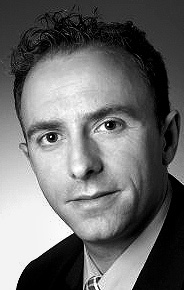GIT-Interviewwith Verint Systems Managing Director Dirk Ostermann
GIT-Interviewwith Verint Systems Managing Director Dirk Ostermann. For transport operators, protecting their passengers, staff and their assets is of paramount importance, and incr...

GIT-Interviewwith Verint Systems Managing Director Dirk Ostermann. For transport operators, protecting their passengers, staff and their assets is of paramount importance, and increasingly so. Whether on trains or buses, combating crime and dealing with the fall-out of crime is a major concern, fraught with challenges. Perhaps the greatest challenge is how to find the most viable, most cost-efficient, and most effective way of dealing with the serious issues of violence and vandalism that plague network operators, reduce passenger numbers, and impact significantly on the bottom line. Heiko Baumgartner had the opportunity to talk to Dirk Ostermann, Managing Director at Verint Systems GmbH, about Verint’s solutions for the transportation business.
The public transport is one of the most attractive targets for terrorism to get attention world wide. Do you see any concepts to prevent and what concepts do you offer to manage this threat?
D Ostermann: With over 8,000 documented incidents of political violence occurring in 71 different nations around the world since 1997, authorities responsible for counter-terrorism measures have not ceased in their attempts to minimise the damage caused by these acts of violence. The fact that historical trends indicate a gradual increase in the number of global terrorist incidents is expected to maintain a healthy level of demand for security technologies and systems for the foreseeable future.
Of all the preferred targets of terrorist violence throughout the world, there are very few that can match mass transit systems as environments that offer the highest amount of casualties for the least amount of effort, as recent incidents in Spain, India and the United Kingdom have shown. Of all the European nations, the countries with the most documented terrorist incidents on mass transit systems are Spain (60%), Russia (21%) and the United Kingdom (6%). Overall, terrorist incidents on mass transit systems in Europe account for approximately 15% of all fatalities directly related to political violence. The scale of the problem is vast.
Verint Systems, as a leading provider of networked video solutions is at the forefront of developing solutions not only to fight terrorism, but just as importantly to tackle the day-to-day challenges that network operators face. A winner of the Company of the Year Award 2007 from Frost & Sullivan for its expertise in mass transit systems, Verint’s solutions are being deployed across all areas of the transport infrastructure, not just on the station platforms, but also on the trains themselves as well as buses and trams to deliver 100% network coverage. And they are proving very effective.
What is the key advantage of using IP solutions for video and why is this mandatory to us the new technology?
D Ostermann: Today there is a clear picture emerging about the next generation of products that will be available to the industry. Increasingly, it will be IP-based solutions that will be utilised – not in the way of stand-alone IP cameras or DVRs but rather technologies fully integrated within the train’s existing IP backbone.
In addition to this, Verint is actively looking to add value to its offerings by acting on customer recommendations and adding further non-security related capabilities and functionalities, such as
- Analytic capabilities that will count the number of people in buses or trains for fleet management purposes.
- An IP-based camera specifically designed for mass transit vehicles that will facilitate automatic video data downloads and also automate equipment “health checks”.
- Nextiva Transit Fleet Manager – a back-end software solution that relieves the security system operators of much of the maintenance and service chores and also backs up all the video data collected to a centralised location.
When you install ‘Intelligent’ IP technology there surely is the aspect of technological improvements, but don’t you have to cover some challenges?
D Ostermann: Of course the IP technology presents challenges. It means that the surveillance ‘products’ deployed will have to take into account the communications restrictions posed by other ‘products’ such as Passenger Information Systems (PIS), for example, with a clear protocol on how and when such surveillance products may be used. They will need to be considerably more ‘intelligent’ than ‘standard’ IP technologies in that they must not interfere with or restrict the use of other essential systems onboard for which the IP backbone was originally intended.
Looked at another way, they need to be able to add value to the technologies already installed, integrating, for example, with the Multi Media Interface (MMI) displays or Train Management Control Systems (TMCS) in the drivers cab so that he can see not only information from the PIS or seat reservation systems, but also live video in the event of an emergency. This concept of accessibility to video is not new, but it is increasingly being taken seriously.
The concept too of being able to harness wireless LANs, ‘Edge’ or 3G networks is also fast becoming a reality. Whilst the infrastructure is not there yet, or is at best patchy, where good coverage isn’t an issue the results are already encouraging.
What do transport operators expect today from their video solution?
D Ostermann: They want more added value, i.e. a value beyond that of simple ‘security’. This is where the issue of Open versus Closed Protocols comes into play. The next-generation video management platform/concept should be designed specifically to address the security challenges faced by mass transit today to enhance the levels of security effectiveness of mass transit security initiatives and helps to proactively counter threats, improve emergency event response, and conduct more productive investigations.
By tailoring its wired and wireless IP-based video products to take into account the inherently mobile nature of mass transit security, the sprawling nature of this threat domain and the unique requirements of each individual mass transit system, The future integrated Closed-Circuit Television (CCTV) security and surveillance solutions allows mass transit security authorities to increase passenger and employee safety, reduce anti-social behaviour and secure transportation infrastructure and vehicles.
What developments do you see in the future regarding video surveillance for public transportation?
D Ostermann: Live video on demand is similarly the next ‘big thing’. The ability for a driver to be able to switch video to his MMI and see exactly what is going on if an emergency button is pushed, for example, is an obvious next step, and one already being trialled. Wireless accessibility is also a hot topic for debate. There is an obvious archiving/storage issue for video onboard rolling stock. This is not simply a factor of space, but rather the life-expectancy of the HDDs used.
The opportunities, therefore of being able to download video off-site rather than on-board and store it safely to disc would remove this potential headache virtually overnight. The technology of the future will not only be about how specific product can help in specific applications. They will also look at the wider fleet management issues. Indeed this is already happening. It is now possible to streamline the management of on-board CCTV systems for up to 1,000 buses or train carriages by enabling them to be centrally configured and managed.
Should an incident occur, new software can transmit live video and data via wireless LAN to central monitoring stations, police departments and other agencies, as well as to mobile video monitors in first response vehicles. Such fleet management technology can upload video automatically or on demand, helping operators respond effectively to important events and build evidence for addressing claims and criminal activity.
Such technology is also self-monitoring, effectively maintaining itself via bespoke automated device health checking and problem notification thereby dramatically reducing device down-time, lowering service and maintenance costs, and helping ensure that critical data is available when needed.
Security is the main field, where video surveillance can help the customer. In the retail business there are additional applications of video e.g. in marketing. Do you see similar possibilities in the transportation sector?
D Ostermann: Video Surveillance is of course key to the network operators’ future. In a railway environment, CCTV will allow a passenger to be ‘followed’ throughout his journey, from the car park, into the ticket office, onto the platform, the train and ultimately on to his final destination. But as you mentioned, new technologies could potentially go even further, and this is again where the idea of ‘value-add’ comes into its own.
Both train and bus operators are looking at how video surveillance can assist in their route planning by counting passengers. The benefits are obvious: the ability to put on more buses or add carriages to trains at peak times to cope with peak passenger numbers improves service and efficiency, and helps ensure appropriate staffing levels are maintained. With the increasing pressure on inter-regional transport operators to demonstrate value for money, the concept of ‘people counting’ also gives far greater visibility in terms of sharing the cost of investment with others.
People counting are one of the technology challenges in the public transport. Do you have experience with ‘people counting’?
D Ostermann: The ‘people counting’ technologies like IR Sensors or beams have already been trialled, but tend to be expensive to run and maintain. There are also issues with accuracy, especially trying to count large numbers of passengers in confined spaces. Video does not provide the panacea, but manufacturers are looking at how specific algorithms can be developed to make counting more accurate.
The first feedback from our NTPC (Nextiva Transit People Counting) trials are very positive and we installed the solution on busses first, because they have smaller doors and that makes counting for video easier compare to the Rail business. Our plan is to launch a people counting concept for busses first, because the challenge is to guarantee an accuracy of 98% of all riders entering and leaving the bus on one day.
Next step will be to enhance the Verint solution for Rail business.
Will there be video surveillance in every bus in the future?
D Ostermann: Trains and buses share many common issues, and solutions. Whilst it might not be practical, for example, to have an IPbackbone for every bus, that does not prevent every bus from having its own built-in video surveillance technology, now as an integral part of the bus’ design, rather than technology fitted retrospectively.
This is an excellent example of how the challenges for European transport operators in the future are considerable, but not insurmountable.
Contact:
Dirk Ostermann
Verint Systems,
Neumünster, Germany
Tel.: +49 4321 26985 0
Fax: +49 4321 26985 99
marketing.emea@verint.com
www.verint.com













